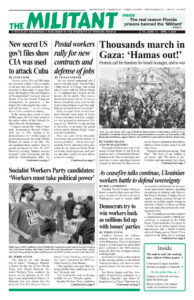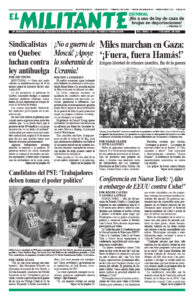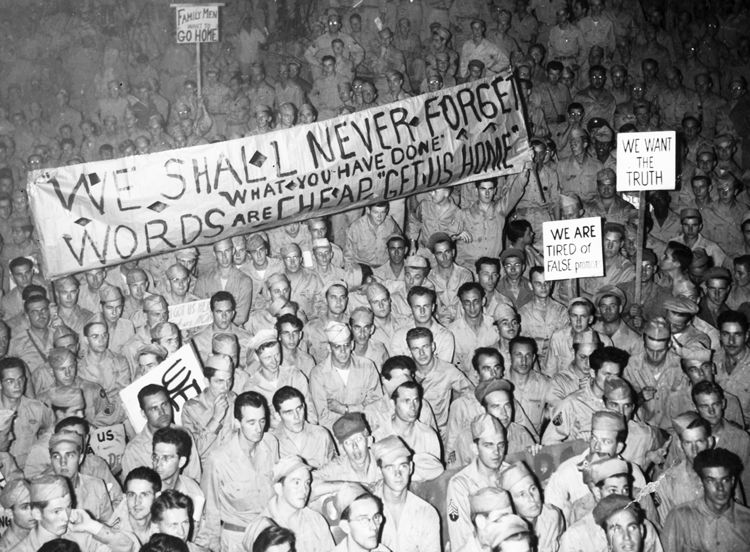One of Pathfinder’s Books of the Month for March is The Struggle for Socialism in the “American Century”: Writings and Speeches, 1945-47 by James P. Cannon, then national secretary of the Socialist Workers Party. The U.S. rulers, after a bloody victory in the second imperialist world war, boasted of an “American Century” of global domination. But that wasn’t to be, Cannon said. He outlined the prospects for working-class revolutionary struggle, confident of victory. That is even more true today, when Washington, the world’s last empire, is in decline, dragging the whole imperialist world disorder down with it. The excerpt is from the SWP’s 1946 convention resolution, “Theses on the American Revolution.” Copyright © 1977 by Pathfinder Press. Reprinted by permission.
The United States, the most powerful capitalist country in history, is a component part of the world capitalist system and is subject to the same general laws. It suffers from the same incurable diseases and is destined to share the same fate. The overwhelming preponderance of American imperialism does not exempt it from the decay of world capitalism, but on the contrary acts to involve it ever more deeply, inextricably, and hopelessly. U.S. capitalism can no more escape from the revolutionary consequences of world capitalist decay than the older European capitalist powers. … The dominant world position of American imperialism now accentuates and aggravates the death agony of capitalism as a whole.
American imperialism emerged victorious from the Second World War, not merely over its German and Japanese rivals, but also over its “democratic” allies, especially Great Britain. Today Wall Street unquestionably is the dominant world imperialist center. Precisely because it has issued from the war vastly strengthened in relation to all its capitalist rivals, U.S. imperialism seems indomitable. So overpowering in all fields — diplomatic, military, commercial, financial, and industrial — is Wall Street’s preponderance that consolidation of its world hegemony seems to be within easy reach. Wall Street hopes to inaugurate the so-called American Century.
In reality, the American ruling class faces more insurmountable obstacles in “organizing the world” than confronted the German bourgeoisie in its repeated and abortive attempts to attain a much more modest goal, namely: “organizing Europe.”
The meteoric rise of U.S. imperialism to world supremacy comes too late. Moreover, American imperialism rests increasingly on the foundations of world economy. … But the world foundation is today shot through with insoluble contradictions; it suffers from chronic dislocations and is mined with revolutionary powder kegs.
American capitalism, hitherto only partially involved in the death agony of capitalism as a world system, is henceforth subject to the full and direct impact of all the forces and contradictions that have debilitated the old capitalist countries of Europe.
The economic prerequisites for the socialist revolution are fully matured in the U.S. The political premises are likewise far more advanced than might appear on the surface. …
While appearing and functioning in the role of stabilizers of capitalism, the American imperialists were thus its greatest disrupters both at home and abroad. The U.S. turned out to be the main source of world instability, the prime aggravator of imperialist contradictions.
In the interim between the two wars this manifested itself most graphically in the fact that all economic convulsions began in the Republic of the Dollar, the home of “rugged individualism.” This was the case with the first postwar crisis of 1920–21; this was repeated eight years later. … The Great American Boom exploded in a crisis which shattered the economic foundations of all capitalist countries.
The economic crisis of 1929 was not a cyclical crisis. … It was a major historical crisis of capitalism in decay, which could not be overcome through the “normal” channels; that is to say, through the blind interplay of the laws governing the market. …
The bourgeoisie saw no way out of the crisis. They had no way out. They and their regime remained the main obstacle in the way not only of domestic but of world recovery. In its downward plunge, the American bourgeoisie dragged the rest of the capitalist world with it, and kept it down. …
American capitalism was incapable of solving the crisis. The partial upswing of 1934–37 proved to be temporary and passing in character. The precipitous drop that occurred in 1937 revealed the abyss facing American capitalism. The threatening new downward plunge was cut off only by the huge expenditures made in preparation for the Second World War. …
[T]he 1929 crisis found the working class helpless and impotent. For three years the masses remained stunned and disoriented by the disaster. Their resistance was extremely limited and sporadic. But their anger and resentment accumulated. The next five years (1933–37), coincident with a partial revival of industry, witnessed a series of gigantic clashes, street fights, and sit-down strikes — an embryonic civil war — the end result of which was a leap, a giant leap, for millions of workers from nonexistence as an organized force to trade union consciousness and organization. Once fairly started, the movement for unionism snowballed, embracing today almost 15 million in all the basic industries.
In one leap — in a brief decade — the American workers attained trade union consciousness on a higher plane and with mightier organizations than in any other advanced country. …
The issue of socialism or capitalism will not be finally decided until it is decided in the U.S. Another retardation of the proletarian revolution in one country or another, or even one continent or another, will not save American imperialism from its proletarian nemesis at home. The decisive battles for the communist future of mankind will be fought in the U.S.


